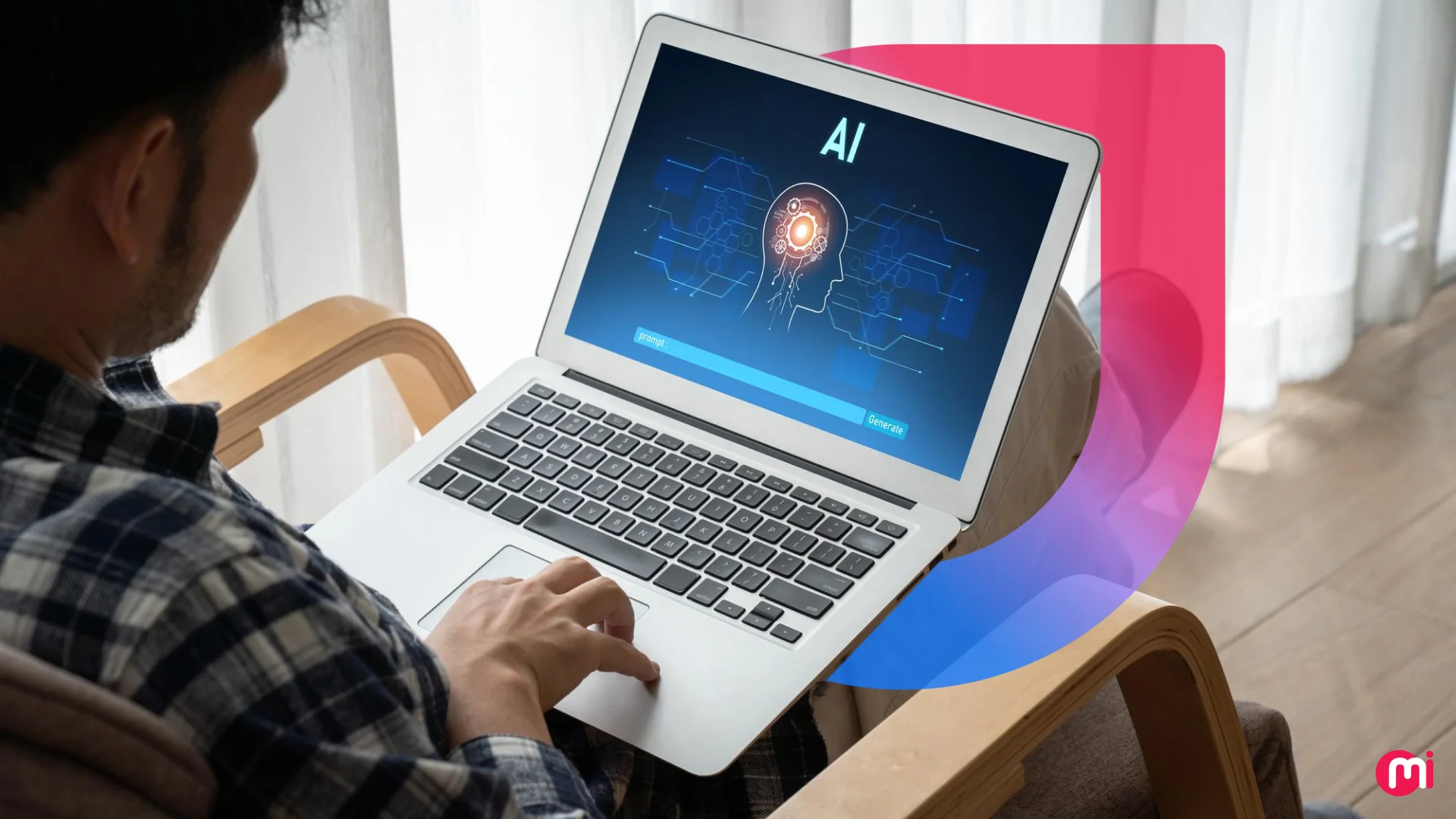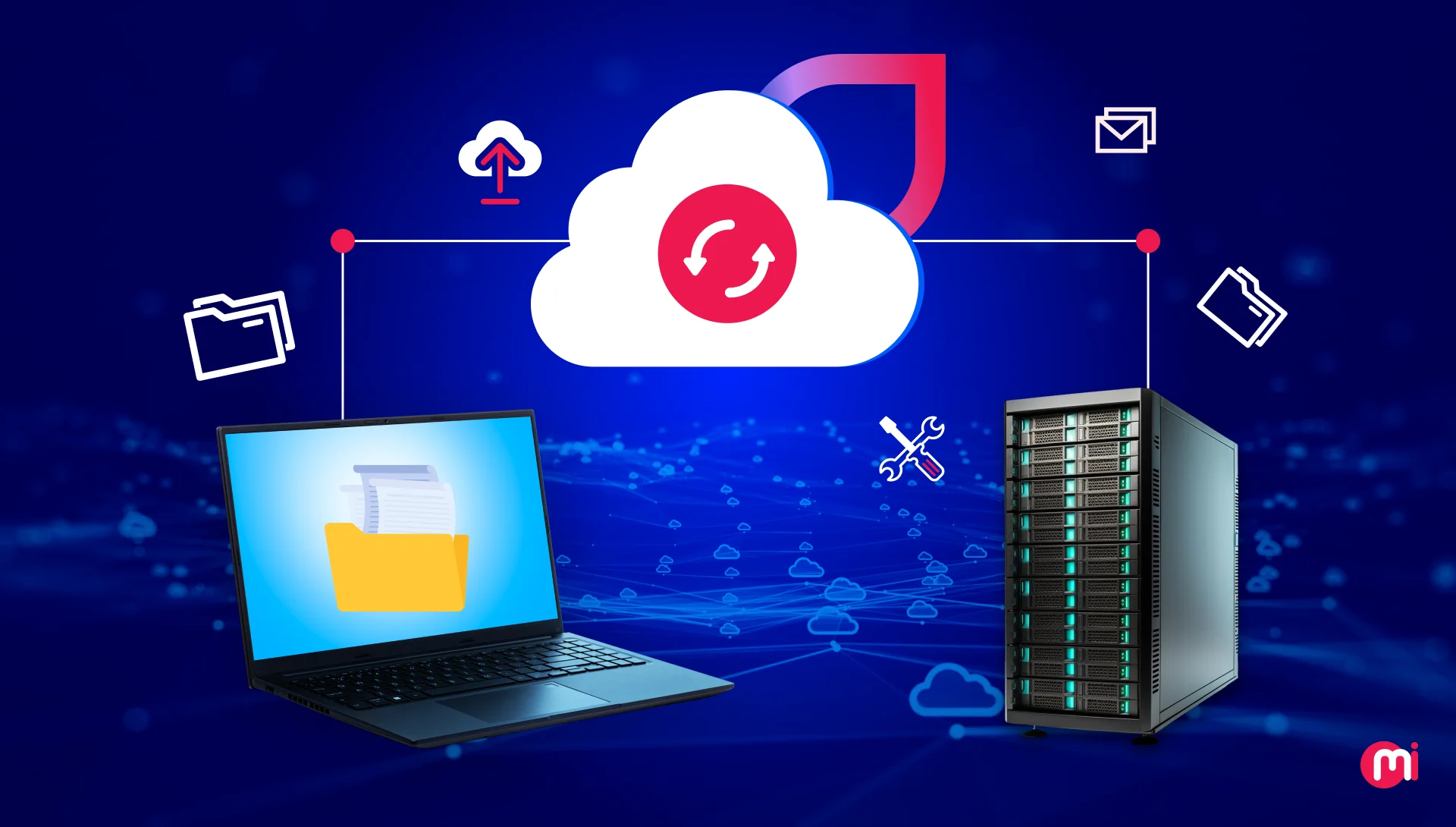AI in Software Development: All You Need to Know
- Software
- December 2, 2024
AI in software development automates tasks, boost productivity while improving code quality. AI helps businesses with code generation, testing, debugging, deployment and constant updation of the product. This blog examines everything about AI software development, including its uses, benefits, real-life use cases, challenges, solutions as well as the risk mitigation techniques of the same.
AI in software development is constantly shaping the ever-evolving tech landscape. It is revolutionizing how software development companies conduct product development and delivery. Be it gathering users’ behavior and insights, code generation, or testing & bug fixing, AI is used in software development to perform various tasks throughout the lifecycle.
Organizations including IBM, SAP, Cisco, Lyft, and many more employ tools like OpenAI Codex, DeepCode, Segment, and the like to maximize efficiency in software development. Using these tools, developers can streamline the development with enhanced efficiency and enriched quality of the product.
As it’s just a glance, there’s more to the AI tools, their uses, and benefits in software development services. This blog explores key insights businesses, especially CIOs need to know to effectively leverage AI in software development, making their teams well-equipped to harness the power of this transformative technology.

How AI is Used in Software Development
AI in software development automates various tasks, improves code quality, and enhances the overall development process. AI helps with code generation, automated testing, bug detection & fixing, project management, documentation, security enhancement, and many more. Key areas where AI is used in software development include the following:
Code Generation
AI-enabled tools, including GitHub Autopilot and Copilot, Tabnine, Amazon CodeWhisperer, and Replit AI, allow developers to write code faster and with fewer errors. AI does so by suggesting code or generating complete functions from natural language inputs.
Through autocompletion, AI predicts and suggests the next line of code, boosting the speed and eliminating errors. Besides, AI generates boilerplate code or complete functions as per the description.
Automated Testing
AI-powered tools like IDEs with built-in refactoring features, code quality platforms, and static analysis tools help identify key areas in need of code refactoring and optimization after software deployment.
This aligns with what is software maintenance, which involves ongoing enhancements and issue resolution to ensure optimal performance. These tools frequently monitor performance, detect anomalies, and predict issues to boost the software, its reliability, and reduce the time needed to resolve incidents.
Bug Detection and Fixing
AI-powered tools like Amazon CodeGuru and Bugasura automatically detect vulnerabilities, bugs, or inefficiencies in code by analyzing the patterns within the codebase. AI assesses patterns to anticipate future bugs and suggests or autocorrects code by making use of real-time data to refine prototypes.
Project Management
AI helps with task scheduling, task estimation, resource allocation, resource management, and provides accurate timelines while fostering optimal resource utilization. AI efficiently handles routine project management tasks and analyzes historical data to ensure precise project timelines to optimize resource allocation for specific use cases.
Documentation
AI tools use NLP to automatically generate documentation from code and maintain it, hence turning code into readable explanations and enabling developers to understand and maintain software. AI generates documentation for APIs, projects, and libraries. It localizes technical documents into multiple languages and makes the open-source project accessible from anywhere.
Refactoring and Optimization
AI analyzes code and suggests refactoring strategies to improve code quality, optimize performance, and enhance maintainability. Artificial intelligence detects outdated practices and advises improvements based on computer science best practices to improve code efficiency. For businesses exploring what is AI as a service, these capabilities demonstrate how AI can be delivered as a scalable solution to enhance software development workflows.
Security Enhancement
AI-powered software development tools analyze code, find out vulnerabilities, monitor for security threats, and suggest strategies for mitigation. AI spots risks like cross-site scripting (XSS) and structured query language injections (SQLi) to ensure secure code changes and improved functionality.
DevOps and CI/CD Pipelines
AI in software development automates tasks like monitoring and scaling in CI/CD pipelines. It improves build efficiency and deployment speed. AI detects performance issues in real time while efficiently handling infrastructure tasks, such as load balancing and scaling.
UX Design
AI tools like Uizard, Figma, and Adobe Sensei help automate UI generation while prioritizing tailored user experiences based on data. Using these tools, developers create interfaces aligned with the user’s data, ensuring they are tailored optimally to the user’s expectations. AI-powered A/B testing helps interpret user research to ascertain which design performs better.
Architecture Design
AI in software development suggests optimal software architectures that are aligned with best practices and project requirements. Neural networks asses wider datasets and propose efficient architecture designs even for complex systems like image recognition in healthcare applications.
Artificial intelligence tends to automate solution designs and incorporates scalable frameworks, ensuring an accelerated and consistent software development process.
How AI Impacts the Software Development Lifecycle (SDLC)
AI in healthcare transforms the SDLC by automating processes, speeding up development time, improving code quality, and reducing costs. Using AI improves productivity and optimizes efficiency in each stage of the software development process. Here’s all about how AI impacts SDLC.
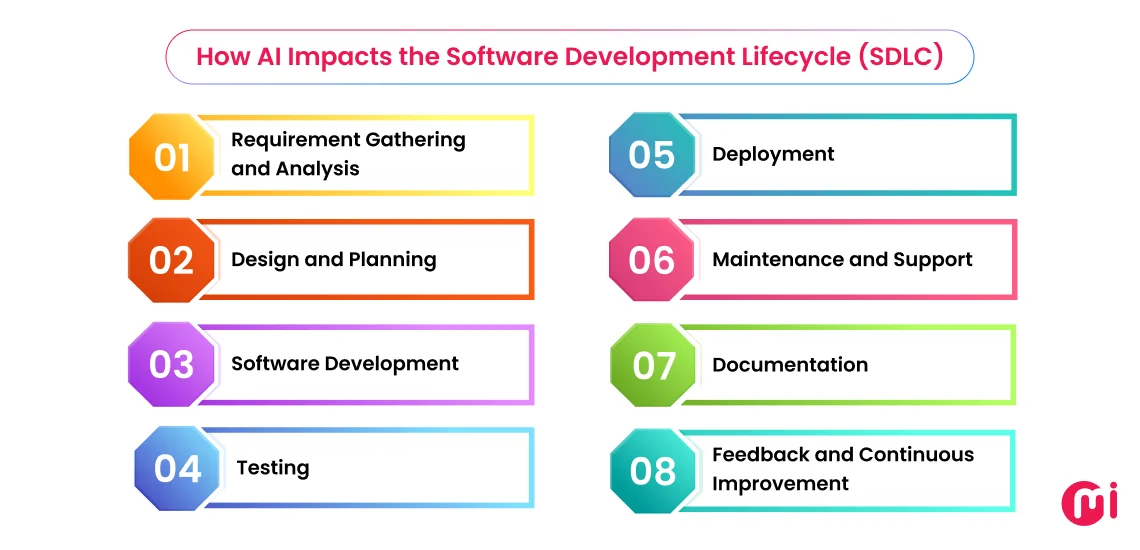
1. Requirement Gathering and Analysis
AI-enabled tools like ClickUp turn high-level software development ideas into detailed requirements. They do so by processing natural language inputs. These tools efficiently analyze business goals and user needs and propose features and anticipate requirements, accelerating the requirements gathering with reduced errors.
2. Design and Planning
AI enhances software design by suggesting optimal UI/UX layouts, architectures, and system designs based on constraints. It generates specifications, mockups, and diagrams, thereby eliminating manual efforts and accelerating the design process. It also allows developers and testers to define and reuse solution architectures and technical designs to improve efficiency and consistency.
3. Software Development
AI in software development helps create code and automate repetitive tasks. These solutions allow developers to focus on complex problems. AI-enabled autocompletion and real-time suggestions assist in boosting the speed and accuracy of software development.
4. Testing
For software testing, AI automates test case generation and execution. It analyzes code for areas that need testing. It tends to find bugs, optimizes coverage early, reducing manual testing, while boosting testing efficiency and software quality.
5. Deployment
AI optimizes CI/CD pipelines by anticipating failures and suggesting adjustments for streamlined releases, accelerated builds, and reduced downtime. Python developers use AI to activate the underlying technical environment and manage the deployment and promotion of the software across different environments. It enables them to ensure seamless transition of software solutions through the development lifecycle.
6. Support and Maintenance
AI-powered tools like IDEs with built-in refactoring features, code quality platforms, and static analysis tools help identify key areas in need of code refactoring and optimization after software deployment. It frequently monitors performance, detects anomalies, and predicts issues to boost the software, its performance, and thereby streamlines reliability and eliminates the time taken to resolve incidents.
7. Documentation
Artificial intelligence tools automate the generation and updating of documentation, ranging from API guides to code explanations. This very feature enables ensuring accurate and up-to-date documentation and relieves software developers of manually conducting these tasks.
8. Feedback and Continuous Improvement
AI in software development allows for intense analysis of performance and user behavior, providing recommendations for improvement for future interactions. It enables developers to prioritize enhancements and valuable features.
Also Read: Best AI Development Companies in the USA.
AI In Software Development: What CIOs Should Be Aware of?
CIOs (Chief Information Officers) are responsible for the processes such as managing, assessing and evaluating how well an organization is managing its IT resources. It makes it crucial for them to know how using AI can revolutionize the entire software development. Here’s all that CIOs need to know about how to use AI in software development:
Accelerated Development Through Automated Code Creation
Right from intelligent code suggestions to efficient code creation, along with error detection and correction, AI speeds up software development through automation when it comes to creating code. Equipped with AI, the integrated development environments (IDEs) offer real-time code suggestions, enabling developers to write code timelessly with mitigated syntax errors.
AI-enabled tools tend to create not only code snippets but also the entire function according to the high-level user inputs and specifications. It helps developers save time spent on repetitive tasks. There are AI tools that interpret natural language descriptions of the needed functionality and turn them into well-functionaling code, speeding the development process.
What’s more, it is capable of analyzing code and identifying potential errors and inefficiencies while suggesting adequate corrections. It minimizes the time taken for debugging.
Enhanced Focus On Complete Software Development Life Cycle Rather Than Just Coding
AI automates code creation; however, it doesn’t end here. Besides coding, it helps with planning, designing, testing, and deployment of the product. The use of AI in software development streamlines the overall productivity by around more than 40%.
In order to gain sustainable gains in product quality, productivity, and business value, you need to systematize how you employ AI for specified development archetypes and business domains. Consider systematizing the following:
- Pre-training data, like enterprise standards, architecture, code artifacts, and requirements documents.
- Fine-tune the product’s model.
- Keep the prompt libraries and output templates updated.
- Train people to frequently employ the applicable patterns in their work type.
By doing so, you can leverage the power of AI to ensure sustainable productivity and enhanced value on your investment.
Improved Decision-Making with Data-Driven Insights
The use of AI ensures improved decision-making by offering data-driven insights through various key mechanisms that involve predictive analytics, data analysis, and many more. AI processes vast amounts of data, pinpointing pattrens and trends quickly that may be tough for humans.
AI accumulates data from a variety of resources, such as version control systems and user feedback platforms. It provides a holistic glance at the software development process.
Making use of machine learning algorithms, AI tends to analyze historical data, intending to pinpoint patterns and correlations. It assists developers in understanding previous performance, allowing informed decision-making for the project.
Employing AI in software development, teams make informed-decisions based on real-time data rather than on intuition.
Strategic Alignment of AI with Specific Business Goals
Strategic alignment of AI with specific business goals is essential to ensure your software development initiative directly contributes to your organization’s goals. It helps you develop a product that enhances resource utilization, and provides measurable results, fostering cross-functional collaboration.
When having a proper understanding, the development teams are more likely to yield AI solutions with competencies to improve efficiency and drive innovation, enhancing the user experience. What’s more, proper alignment of AI strategies with your business goals delivers excellent stakeholder buy-in, reduces risk, increases competitive advantage, and eventually delivers sustainable business growth.
Developing a Scalable AI Infrastructure
Be it aligning with ever-evolving demand, ensuring flexibility and adaptability, or faster performance with cost-effectiveness, developing a scalable infrastructure is needed for AI-enabled software development.
As time goes by, the user’s needs grow, data volumes expand, and a scalable infrastructure ensures the software easily accommodates this change with no degradation in performance. A robust infrastructure allows you to integrate new AI models and technologies with optimal ease, allowing it to adapt to evolving requirements and innovations.
A scalable system optimizes resource utilization and allows you to pay only for what you actually need. Besides, it ensures rapid development and deployment of AI-powered solutions, streamlining the time to market your product.
Gathering a Sufficient Amount Of Relevant, Logical, And High-Quality Data
Be it model accuracy, bias mitigation, feature extraction, or robustness, having adequate amounts of relevant, logical, and high-quality data is a must. High-quality data is crucial to train the AI models with efficacy. It promotes the accuracy and reliability of predictions, helping AI solutions perform well in real-world apps.
Diverse and representative datasets are needed, as they help you mitigate bias in AI models, allowing for more fair and equitable outcomes. It’s crucial to maintain trust and compliance with optimized ethical standards.
Inadequate Human Skills Can Be The Biggest Risk
In traditional human pair programming, when a junior and senior developer are paired, there is often chances of a risk of the “Watch the Master” phenomenon. Here, the junior one is more likely to be excessively reliant on the senior one, leading to the feasibility of a lack of learning and skill development.
Internal events like hands-on training, workshops, and real-life case studies play a crucial role in sharpening the skills and abilities of those with improper skills. It makes them more AI-savvy, enabling them to develop critical thinking and problem-solving competencies.
Be it strategists, designers, or developers, the ones guiding juniors must have vigilant reviewing and problem-solving skills for AI-generated content.
The Agile Principle Needs to Evolve For The Age of AI
The Agile software development methodology came into existence over 2 decades ago that now needs to evolve. It should change to address challenges and grab opportunities posed by new-era AI-enabled software development.
Agile emphasizes human interaction, client collaboration, and adaptation to ever-evolving change which now, needs to incorporate the values that reflect the integration of AI tools and methods.
It should emphasize the speed and efficiency powered by AI with a relentless focus on crafting business and customer value.
The Use Of Proprietary Data For Custom AI Model Training Offers a Competitive Edge Over Generic Public Models
Using proprietary data for custom AI model training offers tailored solutions, thereby enhancing performance. Enterprises make use of unique corporate data and expertise to train tailored AI models customized to their specific business needs, standards, and AI infrastructure, for instance, enterprise APIs.
Trained using proprietary data, the tailored AI models lead to completely customized and effective solutions. Optimized for specific use cases, these AI models outperform the generic models, enhancing relevance and accuracy.
Making investments in data curation and fine-tuning custom models streamlines the progress as compared to the public models alone. What’s more, training employees to prompt these customized models enhances differentiation.

Benefits of AI In Software Development
AI offers significant advantages in software development, primarily by automating tasks, improving code quality, and enhancing project management. It can automate repetitive tasks like code generation and testing, freeing up developers for more complex work. AI also improves code quality by identifying bugs and suggesting optimizations, and can help in faster decision-making and planning.
A survey by GitHub states that 92% of developers in the USA use AI coding tools, which showcases the significance of artificial intelligence in software development. The following are the top benefits of AI in software development:
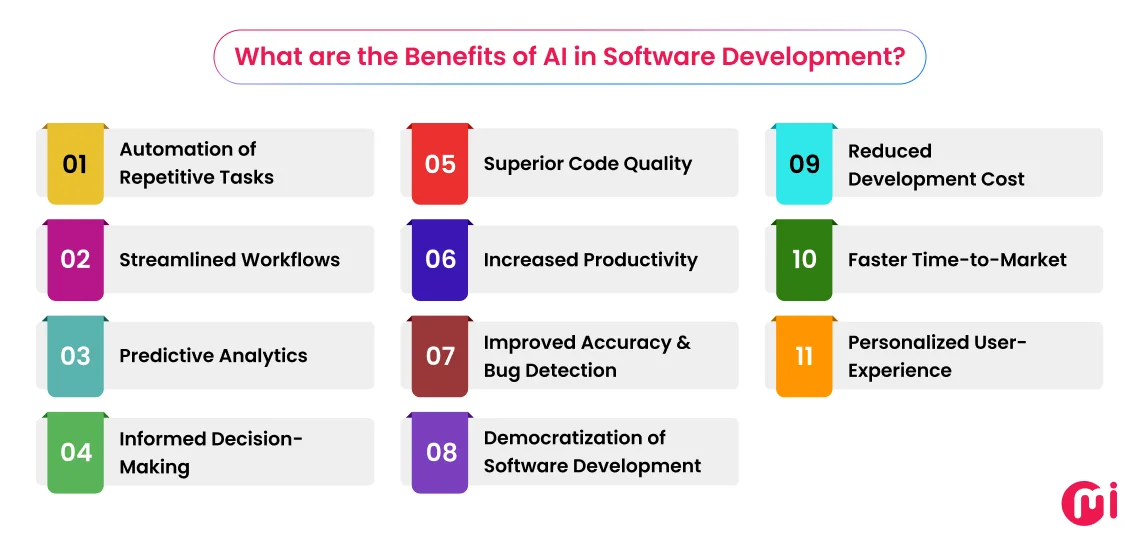
Automation of Repetitive Tasks
AI-powered tools like GitHub Copilot, OpenAI’s Codex, and Amazon CodeWhisperer automate many repetitive tasks in software development. These tools leverage machine learning and other AI techniques to automate tasks in software development, including automated code generation, testing, deployment, and even security assessment and improvement. It enables developers to be focused on more complex tasks and plan strategically for the project’s success.
Streamlined Workflows
AI in software development significantly streamlines the workflows by speeding up various processes. It automates different tasks like code creation, improving collaboration, and streamlining many other stages, like testing and deployment of the development process. This leads to accelerated software development, reducing the time it takes to bring products to market.
Predictive Analytics
AI makes use of predictive analysis for predictive analytics, allowing for detecting potential issues, optimizing resource allocation, and improving the overall outcomes. It employs machine learning algorithms to analyze historical data, find out patterns, and forecast future events, fostering proactive decision-making and efficiency gains.
Informed Decision-Making
Real-time data analysis allows developers and project managers to analyze wider datasets and gain valuable insights for daily operations and strategic planning. With predictive analysis, AI forecasts outcomes by analyzing data patterns, enabling teams to predict challenges, allocate appropriate resources, and adjust timelines proactively. For instance, AI suggests adjustments in case it predicts any delay because of unforeseen complexities.
This real-time feedback fosters up-to-date information, allowing informed decision-making for software development.
Superior Code Quality
With AI-powered code review tools like DeepCode, CodeGuru, and Codacy, developers can ensure optimized code quality. Using machine learning algorithms, these code review tools analyze code, pinpoint potential bugs, and recommend appropriate improvements. For example, AI-powered tools have the potential to automatically check for common problems such as syntax errors, performance issues, and security vulnerabilities, ensuring issues are identified before escalation.
Increased Productivity
AI automates repetitive tasks such as code creation, testing, and debugging, allowing developers to focus more on other complex and creative tasks, ensuring increased productivity in software development. It not only fosters efficiency but also paves the way for innovation by allowing developers not to be busy doing mundane tasks.
AI-enabled tools, such as continuous integration and continuous deployment (CI/CD) systems, allow seamless transitions between software development stages. They automatically manage builds, perform tests, and deploy applications, mitigating bottlenecks and helping projects move forward smoothly.
Improved Accuracy & Bug Detection
AI performs code analysis, ensuring efficient bug detection and enhanced accuracy. For example, static code analysis tools intensively examine code and identify potential bugs and vulnerabilities prior to the deployment of the software. Developers make use of tools such as ESLint and SonarQube to get real-time insights into code quality and alerts relating to issues that may otherwise go unnoticed.
Democratization of Software Development
The no-code and low-code platforms, leveraging AI, allow even nontechnical ones to build and customize applications without deep programming expertise. These platforms allow business professionals, product managers, and other stakeholders to build software solutions tailored to their specific business needs.
Reduced Development Cost
AI in software development leads to significant cost savings. Here’s how!
Automating repetitive tasks like generating boilerplate code and offering real-time suggestions for bug fixes, AI streamlines the development process, resulting in increased financial savings by decreasing manual work. AI-powered tools automatically point out and fix the bugs, hence reducing testing time and saving huge amounts of cost on the development.
Faster Time-to-Market
Using AI not only cuts down the cost of software development but also streamlines the product’s time-to-market. As AI helps automate repetitive tasks, it reduces the need for extensive time consumption, maximizes resource allocation, and streamlines the overall software development process. Leveraging AI in software development is an excellent move towards efficient and timely delivery of the software product.
Personalized User-Experience
Be it user behavior data like clickstreams and session duration or performance metrics such as error logs and load times, AI helps developers analyze user data and develop solutions tailored to the individual’s needs and preferences, resulting in an enhanced user experience. AI-enabled interfaces are becoming more popular as ML algorithms allow them to adapt to users’ behavior to make interactions smoother and more convenient.
Challenges of AI in Software Development and their Solutions
AI integration in software development comes with several challenges, including data quality and bias, high demand for tech talents, privacy concerns, skill gaps, and many more. Overcoming these challenges requires careful strategy, planning, and a multifaceted approach. Here are a few of the challenges of implementing AI in software development and their solutions you should know:
Higher Demand for Skilled AI developers
The demand for AI developers exceeds the supply, making it one of the challenges to hire skilled AI developers.
Solution: Businesses should search, examine and hire AI developers with experience and expertise to fulfil their expected business goals.
Data Quality and Bias
AI algorithms need wider datasets to be trained and learned to make accurate predictions. Inappropriate data quality may impact the accuracy and fairness of AI models.
Solution: Organizations should ensure abiding by the robust data governance practives, careful data collection, thorough bias detection, and ongoing monitoring to avoid the very challenge.
Complexity In Algorithm Design
Designing and implementing efficient AI algorithms requires intensive domain knowledge and expertise, and a strong grasp of mathematical principles and significant experimentation.
Solution: Businesses should consider investing in uninturupted learning for their team members using proven algorithms and frameworks while adopting modular and scalable design practices.
Unforeseen Edge Cases and Unusual Scenarios
AI systems are more likely to perform well on general datasets, however, they might fail in rare or unexpected circumstances.
Solution: AI developers should consider rigorous testing across diverse datasets, make use of simulation environments to mimic edge cases, and consider following reinforcement learning techniques. Besides, continuous updates and user feedback loops help them improve the model and deal with unforeseen conditions.
Privacy and Security
AI relies heavily on data, which raises concerns about privacy and security, particularly when dealing with sensitive information.
Solution: AI developers need to ensure implementing robust data privacy and security measures and data governance frameworks.
Real-Life Use Cases of AI In Software Development
The following are some of the real-life AI use cases in software development, illustrating how it’s utilized effectively:
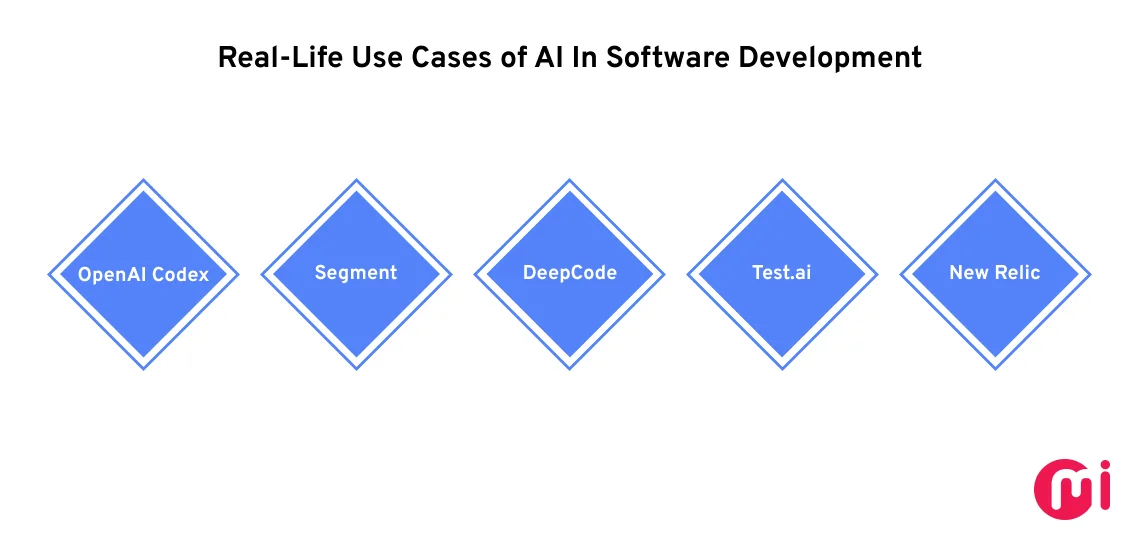
- OpenAI Codex: This tool generates code from natural language descriptions, allowing developers to implement features timelessly without starting from scratch. Organizations like the MIT Department of Electrical Engineering and Computer Science (EECS) uses OpenAI Codex to accelerate coding procedures.
- Segment: Developers use this tool to analyze users data and behaviors to gain deeper insights and prioritize features based on the needs and preferences of users. Intuit and IBM leverage this very tool to unify customer data and create tailored experiences to optimize products as per the user’s behavior and insights.
- DeepCode: This AI tool provides automated code review by analyzing code repositories for bugs and vulnerabilities. It provides developers with real-time feedback while coding. Developers use DeepCode to improve code quality and mitigate bugs in a software solution. Organizations like Nexthink and SAP use DeepCode to enhance code quality and security.
- Test.ai: This tool automates testing for mobile and web applications to simulate user interactions. Companies like Instacart use Test.ai to enhance testing processes, intending to ensure faster release cycles and improved application stability.
- New Relic: It’s an application performance monitoring tool that uses AI to detect unusual patterns in app performance. This tool alerts teams about issues before they impact the users. Organizations like Cisco and Lyft employ New Relic to enrich the performance and availability of their applications.
How to Mitigate the Potential Risks of AI in Software Development
The following are the risks associated with the use of AI in software development:
- AI tends to introduce legal risks by potentially exposing organizations to lawsuits relating to protected or copyrighted content as well as information and data.
- AI is likely to amplify biases and create a “black box,” an AI system with a lack of visibility into operations and inputs.
- The development of AI-powered systems needs considerable investment in tech and talent, which, at times, may not bring expected ROI.
- An in-house setting may lack the required expertise to effectively implement and manage AI solutions, which is likely to hinder successful and efficient deployment and use.
- Integrating AI into existing systems is likely to lead to compatibility issues, causing increased complexity and potential disruptions in software development processes.
- Using sensitive or personal data to train AI may lead to violations in privacy and non-compliance with regulations like the CCPA or GDPR.
- The sensitive data and intellectual property of your organization can be utilized to generate responses to users outside the organization. This may involve employees, service providers, and hackers.
Solution: To reduce the risk of AI in software development, businesses should implement appropriate legal reviews and copyright compliance, enforce ethical AI practices to lessen bias and prioritize transparancy in AI operations. They should consider strategic investment planning, upskilling teams, and expert collaboration to optimize the ROI.
Furthermore, ensuring secure integration, robust data governance, regulatory compliance (GDPR/CCPA), and safeguarding proprietary data from unauthorized access are crucial. Following these measures collectively ensures responsible and efficient AI adoption.
AI-Led Software Development with MindInventory
MindInventory is a top-rated AI development company, the first choice of businesses for comprehensive software development services. Leveraging more than a decade of experience and expertise, we’ve built many AI-enabled solutions, for instance, Passio.ai, Novatech, and many more for businesses of different kinds.
Passio.ai is a cutting-edge AI-enabled solution that enables organizations to incorporate vertical-specific computer vision functionalities into apps. It fosters AI-driven sales and UX experiences. Passio.AI brings 97% accuracy for Nutrition AI, 95% accuracy for Paint.AI, and 27% reduction in dietary mistakes.
Novatech on the other hand, is an AI-powered Safety Chatbot Solution for workers on construction sites. Novatech experienced a 71% increase in site safety awareness, around 56% improved work collaboration, and a 59% reduction in hazardous events.
Do you have a requirement for AI-powered software development? If yes, entrust us to partner with you and help you develop a solution that ensures an optimal outcome. Trusted by more than 1600 businesses across the globe, you can choose us to hire dedicated AI developers and turn your ideas into reality.
FAQs About AI In Software Development
AI is used in software development for multiple purposes. These include project planning and resource allocation, code creation, summarizing codes, generating documentation, automating code testing and debugging, and many more.
GitHub Copilot, Tabnine, Replit, Kite, and CodeGeeX are a few among many free AI tools for coding, easing the process of software development.
Right from generating, optimizing, and testing codes to analyzing user behavior, making data-driven decisions, and automating various tasks, there are plenty of benefits to using AI in software development. It frees up developers from manual tasks, allowing them to focus more on other significant tasks.
